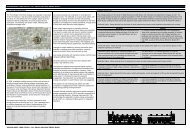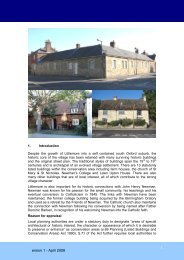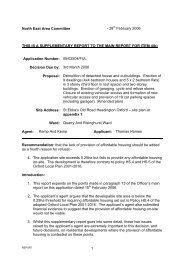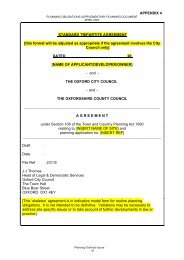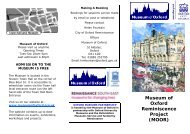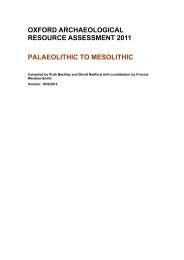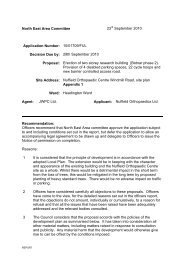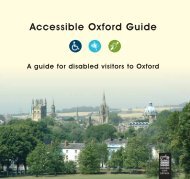Post-medieval Oxford - Oxford City Council
Post-medieval Oxford - Oxford City Council
Post-medieval Oxford - Oxford City Council
You also want an ePaper? Increase the reach of your titles
YUMPU automatically turns print PDFs into web optimized ePapers that Google loves.
Taverns<br />
Taverns were specifically licensed by statute for selling wine, and the allowance of<br />
three to <strong>Oxford</strong> was effected by both the city and university, resulting in five or more<br />
premises at any time (Salter 1926; Leeds 1941). The principal ones were The<br />
Mermaid (Swyndelstock) at Carfax, The Crown at No. 3 Cornmarket, The King’s<br />
Head in High Street, The Salutation in High Street, and The Three Tuns in High<br />
Street. Wine bottles from <strong>Oxford</strong> taverns and colleges have been subject to several<br />
articles, as discussed further below (Leeds 1949; Haslam 1970; Banks 1997).<br />
Village inns<br />
Further work is required to assess the survival of post <strong>medieval</strong> inns and their<br />
outbuildings in the LAA. The White Hart in Marston has been subject to an evaluation<br />
and building survey (Hiller 2002).<br />
Breweries and malthouses<br />
The Lion Brewery in St Thomas Street was established c.1597. It was taken over by<br />
Morrell's from Tawney's in 1803. A brewery on St Thomas’ Street was recorded on<br />
post-<strong>medieval</strong> leases from 1718 until 1803 when it became the Morell’s Brewery<br />
(Munby and Dodd 2006: 481). The premises were surveyed in 1998 and 1999<br />
(<strong>Oxford</strong> Archaeological Unit 1999; RCHME 1998) when the earliest standing<br />
buildings were found to date from c.1730. Morrell's were taken over in the late 1990s.<br />
Excavations in 1976 and 1999 have produced limited evidence for the early<br />
development of the site (Moore 2006; UAD 537).<br />
The Swan, originally Swan's Nest, Brewery existed in Paradise Street by 1718. It was<br />
acquired by Sir John Treacher in 1780 and passed to William Hall in 1795. Hall's was<br />
taken over in the early 20th century. In 1977, excavations found garden remains and<br />
earlier walls below the brewery (<strong>Oxford</strong> University Archaeological Society 1978).<br />
The malthouses on Tidmarsh Lane were first recorded on a post-<strong>medieval</strong> lease of<br />
1772 detailing a malthouse, garden and waste land on the plot (Munby and Dodd<br />
2006: 476). Ongoing investigations at the new Pembroke Quad have uncovered<br />
evidence for brewing on Brewer Street (<strong>Oxford</strong> Archaeology forthcoming).<br />
Tanning<br />
A Tannery is shown in Malchair’s 1772 drawing of the bottom of Littlegate Street, as<br />
indicated in Taylor’s 1750 map. Evidence for tanning waste and related structures<br />
has been excavated at the Brewer Street/Littlegate excavations in 2011 (<strong>Oxford</strong><br />
Archaeology forthcoming). For knucklebone floors and their association with carcass<br />
processing see above. Cattlebones, perhaps tanning waste were recorded at the<br />
Ashmolean Museum in 1994 (Andrews and Mepham 1997: 221). Horn core waste<br />
was also recovered from an 18 th century pit on the former Greyfriars site (Hassall and<br />
Halpin et al. 1984: 174).<br />
Firewood<br />
The supply of firewood (and charcoal) to <strong>Oxford</strong> is an under-researched topic, though<br />
we know that charcoal was sold in the <strong>medieval</strong> street market, and Loggan’s 1675<br />
college views often show large wood piles. The preference for oak and hazel<br />
firewood in the early <strong>medieval</strong> period appears to change to beech in the <strong>medieval</strong><br />
period, with the Chilterns a possible source of supply. At Lincoln College, kitchen<br />
beech charcoal dominated the 16 th -18 th century fireplace charcoal deposit (Challinor<br />
2002), however, wood charcoal from 65-67 St Giles provided evidence for the<br />
continued use of oak in this location (Challinor 2008).<br />
Fruit<br />
OXFORD ARCHAEOLOGICAL RESOURCE ASSESSMENT- POST MEDIEVAL<br />
35



